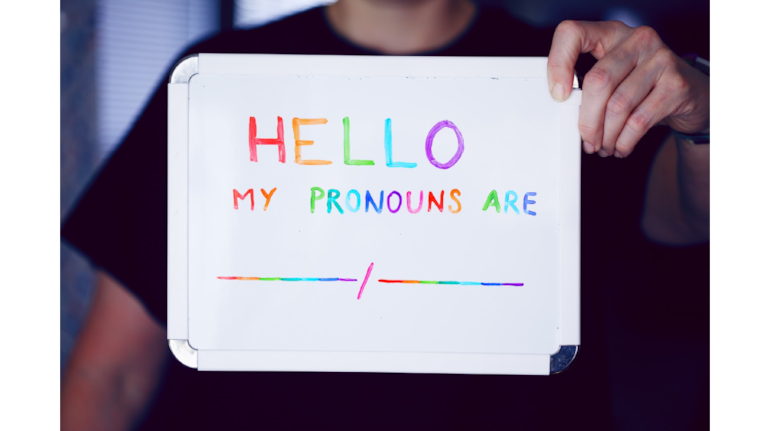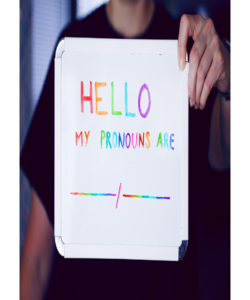
Encouraging all employees to give their pronouns in their email signature is a good idea. (Image via Unsplash)
Diversity, equality, and inclusion (DE&I) – some organizations have made dedicated efforts towards these goals in recent years.
Human Solidarity Foundation Director Aqsa Shaikh says: “Decriminalisation of homosexuality has provided a sort of safety net to the employers, motivating them to hire LGBTQIA+ people.”
“More and more companies are recruiting queer people and showing that off with pride, especially in June (Pride Month). Even if it’s symbolic, that’s happening,” Shaikh adds.
Gaysi Family Editor Tejaswi Subramanian says that more companies “are extending insurance benefits to live-in partners, providing menstruation leaves and parental time-off.” According to Subramanian, initiatives like running an advocacy group driven by allies in companies like Johnson & Johnson is “nice” as it takes the onus off the backs of queer people.
To be sure, these shifts are seen largely in urban, multinational corporations. And even in these workplaces, there’s a lot that still needs to be done. We spoke to several LGBTQIA+ leaders to understand what they feel has changed regarding the inclusion of queer people in a decade and what more needs to be done to make workplaces queer-affirmative.
The challenges
The most challenging aspect of hiring trans and gender nonconforming individuals, says Zainab Patel, chief, D&I, Pernod Ricard India, “is the continued insistence of organisations on meritocracy. They often say they don’t mind hiring trans or gender nonconforming candidates, but the real question is if there’s a large enough talent pool out there? The answer is: No! According to the National Human Rights Commission’s report, there’s an extremely alarming rate of trans people dropping out of schools and educational institutions” – often because of bullying and harassment.
Background verification presents another roadblock, Patel asserts. “Often the gender identity and expression don’t match with those in the documents (which often contain deadnames or names given at birth that have been changed since). Third, besides the stereotypical roles and jobs, organizations don’t have an affirmative plan to ensure career growth of trans people.”
Gaysi Family’s Subramanian says: “As DE&I becomes a burgeoning employer-branding initiative, there seem to be a lot of sensitization exercises, inviting openly queer public figures to deliver talks and be part of events at the workplace, etc. But we are just scratching the surface. Much of it is still woke performance of political correctness, which is great PR, but does little to address the niggling systemic issues of homophobia.”
According to Subramanian, the “power structures continue to exist that keep queer people out of advancement loop in many workplaces”. While “there has been an acknowledgment of past harm”, organization appears to be doing “performative” work, they add.
How to create a queer-affirmative workplace
Gaysi Family’s Subramanian says that “allowing remote work is great”. As is having “pronouns in the (email) signature”.
If the company facilitates opening of salary accounts or issues company credit/debit cards, they should ideally work with a bank that issues cards “with someone’s chosen name, instead of deadnaming them”. Deadnames are names given at birth that are discarded, but which can continue to live on in documents from birth certificates to educational degrees, and bank-issued cards.
Not only that but also “creating Chatham House rules-based discussion groups and workshops to understand the issues faced by queer folks in a particular workplace and unionisation of employees” are key to empowering queer people in workplaces. “Gender-neutral washrooms across the board with provisions for menstruators and making it accessible for people with various disability aids, not just mobility aids,” Tejaswi submits.
Aqsa says that companies must “invest in intent and look beyond pinkwashing” during the pride month. They need to assess whether their “policies are excluding queer and trans people, implicitly or explicitly”. She recommends that the “[overall] infrastructure, not just washrooms, should become friendlier, as not all queer and trans people are able-bodied.”
“Despite [all] that there’ll be situations when things will go wrong, complaints will be made, then it’s important that they’re tackled in a way that such experiences don’t push queer and trans people out of the workplace,” she concludes.
According to Zainab, companies must “demonstrate from a leadership perspective, intent, and visibility that the organisation is truly inclusive and welcoming of LGBTQIA+ people… LGBTQIA+ people must have access to specially curated learning and leadership development [modules], which is absent in India. Additionally, leading organisations must come together and offer a safe space for queer professionals for networking”.
Zainab concludes by saying that organisations must “ask themselves what’s their action plan for next five years regarding LGBTQIA+ inclusion. They must ensure that LGBT talent is not only harnessed but investments are going to be made in LGBT people, especially L, B, and T, in terms of their career development, advancement, education and awareness perspective.”
 Creating employee-resource groups for queer people can help, too. (Representational image: Isi Parente via Unsplash)
Creating employee-resource groups for queer people can help, too. (Representational image: Isi Parente via Unsplash)
India Workplace Equality Index
Co-founder of Pride Circle Foundation and multi-award-winning LGBTQIA+ leader Ramkrishna Sinha says that to help companies assess how they are faring regarding LGBTQIA+ inclusion, their organisation created the India Workplace Equality Index (IWEI). Not only that but Pride Circle also started LGBTQIA+ exclusive job fairs in India and has facilitated 600+ job offers to queer people in various industries.
“[IWEI] is a nine-part survey which is very holistic and looks at all aspects of workplace inclusion: from policy benefits to employee engagement to employee resource groups for LGBTQIA+ people. Based on the submission, [companies] get a score and a band — Gold, Silver, and Bronze. This band gets publicly published. That way, companies get to know how they’re doing in comparison to others. It’s also a great incentive for them to be visible and communicate where they are in the inclusion journey. Additionally, an external stakeholder, for example, a prospective candidate, can examine how the company is doing regarding LGBTQIA+ inclusion and make an informed decision,” Ramkrishna explains.
He says that “DE&I efforts have gained a lot more visibility over the years. The average IWEI score of organisations [we work with] has increased by 7 percentage points from 2020 to 2021. Also, the number of companies hiring LGBTQIA+ people has doubled since we started. So, I believe organisations are going in the right direction, but the pace is slow.”
What can work as a catalyst to accelerate this journey? Ramkrishna feels that the “community members must ask for better workplaces, too; they should check whether their partners are covered, and that the organisation is doing the bare minimum at least by following latest compliance and laws.” He also urges reluctant organisations to learn from the companies that are doing well. “Such organisations will soon learn that they’re losing talent to companies that are better workplaces,” he says.
“Colleagues, especially in urban areas, are more accepting of LGBTQIA+ peers, creating a safer space for the latter,” Shaikh adds. And “companies, too, are providing gay couples insurance packages and funding sex-reassignment surgeries”, so it’s very heartening that organizations “are putting themselves out, saying we stand with the community, changing the logo or infrastructure (gender-neutral washroom), or simply putting out a nice note below the job description that they encourage queer and trans people to apply.”
Check list
• Ensure that your organization is openly declaring that it’s an LGBTQIA+ inclusive workplace.
• Create a queer-affirmative office environment by ensuring that the infrastructure is accessible to all, keeping in mind disabilities beyond mobility.
• Offer equal opportunities to candidates by ensuring that trans and gender nonconforming people get to self-identify and that background verification is smooth for them.
• Build an employee-resource group for queer people, invite trained professionals to organize awareness and sensitisation workshops, and ensure that there’s a safe and welcoming system set up to listen to and investigate complaints made by LGTBQIA+ employees.








